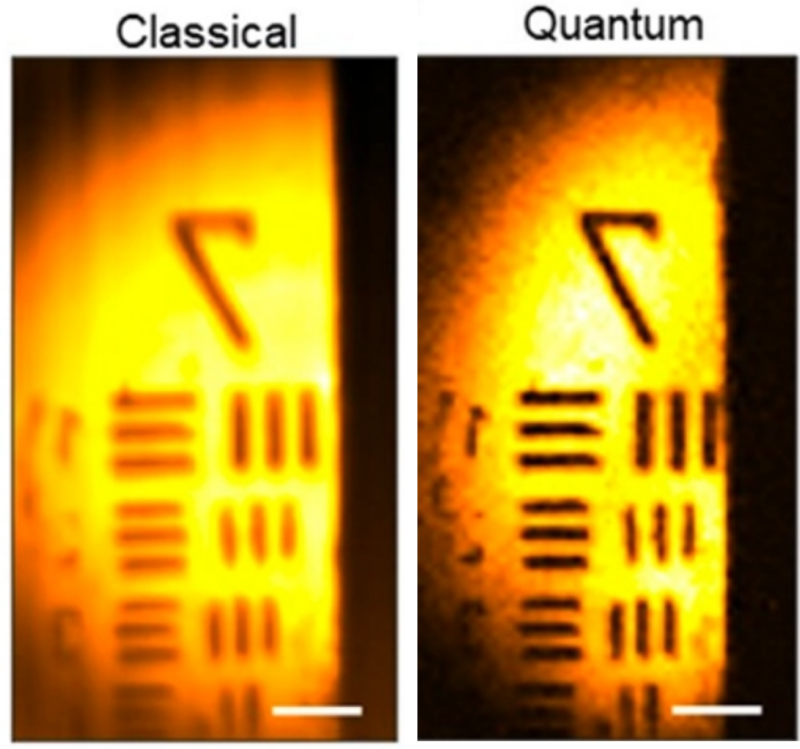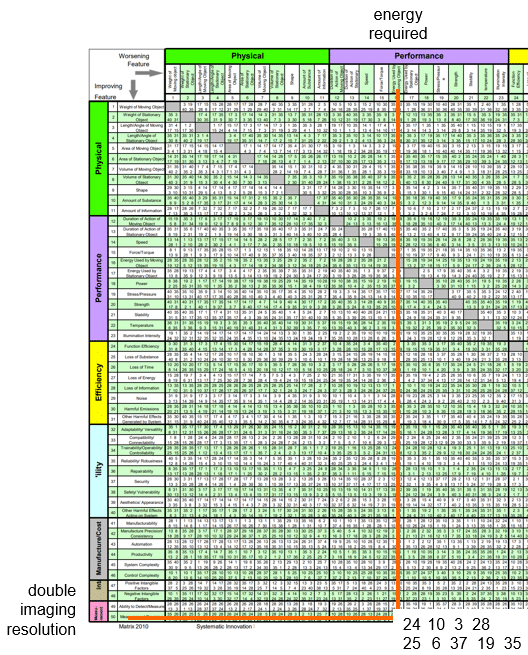
Quantum mechanics. If you think you understand it, to paraphrase Richard Feynman, you don’t understand it. But just because we don’t understand something doesn’t mean we can’t make something useful out of it. Enter a group of researchers from Caltech and their quantum microscopy by coincidence (QMC) solution for doubling the resolution of microscope imaging. And more specifically, contradiction-wise, without the usual complication of dramatically increasing the amount of energy required to do the job.
The problem they’ve solved is the easy part of the sort of reverse-engineering process conducted by the SI research team. Mapped onto the Contradiction Matrix, QMC looks something like this:

Now for the tricky part. How did the research team solve the conflict?
As far as I can tell, there are three parts to the solution.
The first relates to quantum entanglement, a phenomenon that describes correlations between objects – photons in this case – that have a shared history prior to being observed. Or, as the researchers tell it, ‘just as two shoes bought at a store are correlated to fit a right foot and a left foot, particles can be mathematically correlated in a variety of ways too. Only in a quantum system, things like shoes and electrons don’t truly settle on any of those states until they’re observed. They’re merely probabilities best described as a wave of maybes’.
If that hasn’t blown your mind, they go on to say, ‘One photon is sent through the material being studied, while the other photon is analysed. Being entangled, the correlations measured in either photon will also say something about the journey of its partner. It’s the basis of another fairly novel technology called ghost imaging’. From an Inventive Principle perspective, I think this correlation between two photons idea is a fairly clear illustration of Principle 37 in its ‘Relative Change’ form.
(For future reference, the ‘ghost imaging’ quantum phenomenon underpinning the Relative Change measurement, and the idea that one photon carries ‘a memory’ of another sounds like Principle 7, Nested Doll. Or possibly Principle 23, Feedback.)
The second aspect of the solution, meanwhile, is a little easier to describe. Here are the authors again, ‘In QMC, the particles involved were photons, or light particles, which are known as biphotons… a very small fraction of the photons – only around one in a million – are converted into biphotons’. Here’s Principle 3, Local Quality in action.
Finally, the easiest bit… the one-in-a-million biphotons were created by passing a laser light (Principle 28) through a special kind of crystal made from β-barium borate (BBO). Hello, Principle 35, Parameter Changes.
All in all, even though the Matrix knows less about quantum mechanics than me, I’d have to say that it did a pretty good job of identifying the Inventive Principles we can see in the QMC solution. I can’t yet go so far as to say that the Matrix is quantum compatible, but when things like quantum entanglement and ghost imaging sit well within the bounds of the 40 Inventive Principle, I continue to be confident that the $250k reward I’ve been offering for the last decade to anyone that can find me a genuine 41st Principle remains safe.
Interested readers can find a more complete description of the solution here: https://blog.sciencenatures.com/2023/05/light-microscopes-see-smaller-than-ever.html
